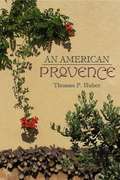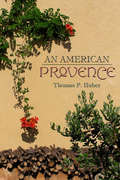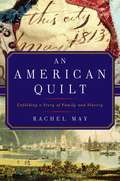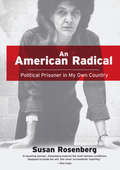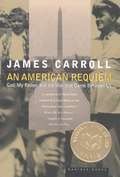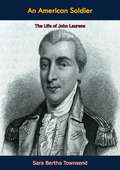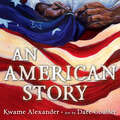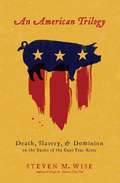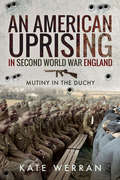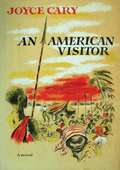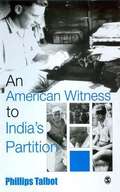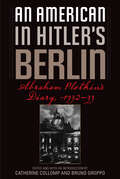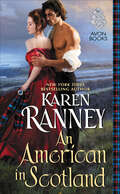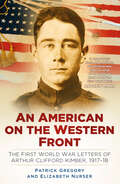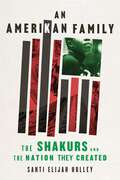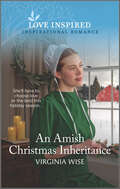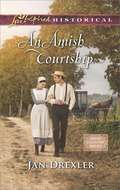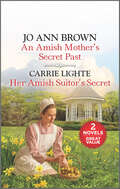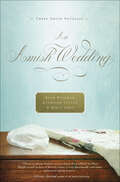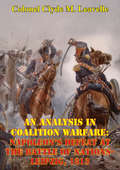- Table View
- List View
An American Provence
by Thomas P. Huber"I have talked about luscious wines and succulent fruit and exquisite dinners. But there may be no more evocative experience of the two valleys than the smell of new-mown hay in the fields at dusk. If a person were to close their eyes, they could not tell if they were in Provence or the North Fork Valley. That sweet, earthy odor is part of the beauty of these places." -From An American Provence In this poetic personal narrative, Thomas P. Huber reflects on two seemingly unrelated places-the North Fork Valley in western Colorado and the Coulon River Valley in Provence, France-and finds a shared landscape and sense of place. What began as a simple comparison of two like places in distant locations turned into a more complex, interesting, and personal task. Much is similar-the light, the valleys, the climate, the agriculture. And much is less so-the history, the geology, the physical makeup of villages. Using a geographer's eye and passion for the land and people, Huber examines the regions' similarities and differences to explore the common emotional impact of each region. Part intimate travelogue and part case study of geography in the real world, An American Provence illuminates the importance sense of place plays in who we are.
An American Provence
by Thomas P. Huber"I have talked about luscious wines and succulent fruit and exquisite dinners. But there may be no more evocative experience of the two valleys than the smell of new-mown hay in the fields at dusk. If a person were to close their eyes, they could not tell if they were in Provence or the North Fork Valley. That sweet, earthy odor is part of the beauty of these places." -From An American Provence In this poetic personal narrative, Thomas P. Huber reflects on two seemingly unrelated places-the North Fork Valley in western Colorado and the Coulon River Valley in Provence, France-and finds a shared landscape and sense of place. What began as a simple comparison of two like places in distant locations turned into a more complex, interesting, and personal task. Much is similar-the light, the valleys, the climate, the agriculture. And much is less so-the history, the geology, the physical makeup of villages. Using a geographer's eye and passion for the land and people, Huber examines the regions' similarities and differences to explore the common emotional impact of each region. Part intimate travelogue and part case study of geography in the real world, An American Provence illuminates the importance sense of place plays in who we are.
An American Quilt: Unfolding A Story Of Family And Slavery
by Rachel MayFollowing the trail left by an unfinished quilt, this illuminating saga examines slavery from the cotton fields of the South to the textile mills of New England—and the humanity behind it. When we think of slavery, most of us think of the American South. We think of back-breaking fieldwork on plantations. We don’t think of slavery in the North, nor do we think of the grueling labor of urban and domestic slaves. Rachel May’s rich new book explores the far reach of slavery, from New England to the Caribbean, the role it played in the growth of mercantile America, and the bonds between the agrarian south and the industrial north in the antebellum era—all through the discovery of a remarkable quilt. While studying objects in a textile collection, May opened a veritable treasure-trove: a carefully folded, unfinished quilt made of 1830s-era fabrics, its backing containing fragile, aged papers with the dates 1798, 1808, and 1813, the words “shuger,” “rum,” “casks,” and “West Indies,” repeated over and over, along with “friendship,” “kindness,” “government,” and “incident.” The quilt top sent her on a journey to piece together the story of Minerva, Eliza, Jane, and Juba—the enslaved women behind the quilt—and their owner, Susan Crouch. May brilliantly stitches together the often-silenced legacy of slavery by revealing the lives of these urban enslaved women and their world. Beautifully written and richly imagined, An American Quilt is a luminous historical examination and an appreciation of a craft that provides such a tactile connection to the past.
An American Radical: Political Prisoner in My Own Country
by Susan RosenbergOn a November night in 1984, Susan Rosenberg sat in the passenger seat of a U-Haul as it swerved along the New Jersey Turnpike. At the wheel was a fellow political activist. In the back were 740 pounds of dynamite and assorted guns. That night I still believed with all my heart that what Che Guevara had said about revolutionaries being motivated by love was true. I also believed that our government ruled the world by force and that it was necessary to oppose it with force. Raised on New York City's Upper West Side, Rosenberg had been politically active since high school, involved in the black liberation movement and protesting repressive U.S. policies around the world and here at home. At twenty-nine, she was on the FBI's Most Wanted list. While unloading the U-Haul at a storage facility, Rosenberg was arrested and sentenced to an unprecedented 58 years for possession of weapons and explosives. I could not see the long distance I had traveled from my commitment to justice and equality to stockpiling guns and dynamite. Seeing that would take years.Rosenberg served sixteen years in some of the worst maximum-security prisons in the United States before being pardoned by President Clinton as he left office in 2001. Now, in a story that is both a powerful memoir and a profound indictment of the U.S. prison system, Rosenberg recounts her journey from the impassioned idealism of the 1960s to life as a political prisoner in her own country, subjected to dehumanizing treatment, yet touched by moments of grace and solidarity. Candid and eloquent, An American Radical reveals the woman behind the controversy--and reflects America's turbulent coming-of-age over the past half century.
An American Requiem: God, My Father, and the War that Came Between Us
by James CarrollNational Book Award winner: This story of a family torn apart by the Vietnam era is &“a magnificent portrayal of two noble men who broke each other&’s hearts&” (Booklist). James Carroll grew up in a Catholic family that seemed blessed. His father, who had once dreamed of becoming a priest, instead began a career in J. Edgar Hoover&’s FBI, rising through the ranks and eventually becoming one of the most powerful men in the Pentagon, the founder of the Defense Intelligence Agency. Young Jim lived a privileged life, dating the daughter of a vice president and meeting the pope—all in the shadow of nuclear war, waiting for the red telephone to ring in his parents&’ house. James fulfilled the goal his father had abandoned, becoming a priest himself. His feelings toward his father leaned toward worship as well—until the tumult of the 1960s came between them. Their disagreements, over Martin Luther King, Jr. and the civil rights movement; turmoil in the Church; and finally, Vietnam—where the elder Carroll chose targets for US bombs—began to outweigh the bond between them. While one of James&’s brothers fled to Canada, another was in law enforcement ferreting out draft dodgers. James, meanwhile, served as a chaplain at Boston University, protesting the war in the streets but ducking news cameras to avoid discovery. Their relationship would never be the same again. Only after Carroll left the priesthood to become a writer, and a husband with children of his own, did he begin to understand fully the struggles his father had faced. In An American Requiem, the New York Times bestselling author of Constantine&’s Sword and Christ Actually offers a benediction, in &“a moving memoir of the effect of the Vietnam War on his family that is at once personal and the story of a generation . . . at once heartbreaking and heroic, this is autobiography at its best&” (Publishers Weekly).
An American Soldier: The Life of John Laurens
by Henry Laurens Sara Bertha Townsend John LaurensOriginally published in 1958, this is the biography of John Laurens (1754-1782), an American soldier and statesman from South Carolina during the American Revolutionary War, best known for his criticism of slavery and his efforts to help recruit slaves to fight for their freedom as U.S. soldiers.In the author’s own words, Laurens hailed from an era that “knew nothing of flamethrowers and submarines, of atomic bombs and guided missiles. To the young republic this man gave his utmost devotion, acting within five momentous years the roles of soldier, legislator, aide-de-camp to the Commander-in-Chief, and Special Minister to France.”
An American Story
by Kwame Alexander#1 New York Times Bestselling and award-winning author of The Undefeated, Kwame Alexander, pens a powerful picture book that tells the story of American slavery through the voice of a teacher struggling to help her students understand its harrowing history. From the fireside tales in an African village, through the unspeakable passage across the Atlantic, to the backbreaking work in the fields of the South, this is a story of a people's struggle and strength, horror and hope. This is the story of American slavery, a story that needs to be told and understood by all of us. A testament to the resilience of the African American community, this book honors what has been and envisions what is to be. With stunning mixed-media illustrations by newcomer Dare Coulter, this is a potent book for those who want to speak the truth. Perfect for family sharing, the classroom, and homeschooling.
An American Trilogy
by Steven M. WiseThe Cape Fear River runs through Bladen County, North Carolina, population 33,000. On its western bank, in the town of Tar Heel, sits the largest slaughterhouse in the world. Deep below the slaughterhouse, one may find the arrowheads of Siouan-speaking peoples who roamed there for a millennium. Nearer the surface is evidence of slaves who labored there for a century. And now, the slaughterhouse kills the population of Bladen County, in hogs, every day.In this remarkable account, Wise traces the history of today's deadly harvest. From the colonies to the slave trade, from the artificial conception and unrecorded death of one single pig to the surreal science of the pork industry-whose workers continue the centuries of oppression-he unveils a portrait of this nation through the lives of its most vulnerable. His explorations ultimately lead to hope from a most unlikely source: the Baptist clergy, a voice in this wilderness proclaiming a new view of creation.
An American Type: A Novel
by Henry Roth“His early novel Call It Sleep was his Ulysses. His late work An American Type is his Grapes of Wrath.”—Thane Rosenbaum, Los Angeles Times This “glorious, evocative, literary novel for the ages” (Los Angeles Times) has finally taken its place within the great canon of American fiction. Set during the Great Depression, against a backdrop of New York’s glimmering skyscrapers and Los Angeles’s seedy motor courts, this autobiographical work concludes the unparalleled saga of Henry Roth, whose classic Call It Sleep, published in 1934, went on to become one of Time’s 100 best American novels of the twentieth century. With echoes of Nathanael West and John Steinbeck, An American Type is a heartrending statement about American identity and the universal transcendence of love.
An American Uprising in Second World War England: Mutiny in the Duchy
by Kate WerranThe shocking story of a WWII shootout between black and white GIs in a quiet Cornish town that put the British-US “special relationship” on trial.On September 26, 1943, racial tensions between American soldiers stationed in Cornwall erupted in gunfire. Labelled a ‘wild west’ mutiny by the tabloids, it became front page news in Great Britain and the USA. For Americans, it bolstered a fast-accelerating civil rights movement, while in the UK, it exposed unsettling truths about Anglo-American relations. With new archival research, journalist Kate Werran pieces together the shocking drama that authorities tried to hush up. Her narrative examines everything from the controversy of American segregation on British soil to the shocking event itself and the resulting court martial.Extracted from wartime cabinet documents, secret government surveys, opinion polls, diaries, letters and newspapers as well as testimony from those who remember it, this story offers a rare window into a little-known dark side of the ‘American Invasion.’
An American Verdict
by Michael J. ArlenA collection of law cases. In Cook County courthouse, in Room 702, which is Judge Philip Romiti's courtroom, the court is in session.
An American Visitor
by Joyce CaryAn American visitor and uninvited guest in the village of Nok, Marie Hasluck is an irrepressible anthropologist who believes that she has found the Kingdom of Heaven in the forests of Nigeria. There, to her eyes, the Birri tribesmen make love and war unfettered by the constraints and complications of Western civilisation; a state which Marie finds enviable and which she does her best to emulate.However, all is not well even in this pagan paradise: white prospectors are staking claims within Birri territory and the eccentric District Officer, Bewser, can no longer keep them at bay, for all his promises to the villagers. As the Birri warriors become increasingly enraged by the colonialists' betrayal and as her own involvement with Bewser deepens, Marie finds that her position as a charmed but distanced onlooker is inevitably compromised.
An American Witness To India's Partition
by Phillip TalbotIn 1938 the New York-based Institute of Current World Affairs awarded 23-year-old Phillips Talbot a fellowship with a mandate: visit South Asia and learn about the intricacies of life in India. Till 1950, Talbot graphically recounted the buildup to Indian and Pakistani independence, and the early experiences of the new states in the form of several letters to the institute. Talbot`s reports from the field, presented here in the original, offer a kaleidoscope of first-hand observations: on student life at the Aligarh Muslim University, local life in a small Muslim community in Kashmir, a Vedic ashram in Lahore, Tagore`s Shantiniketan, Gandhi's Sevagram, crucial sessions of the Indian National Congress and the All India Muslim League, the Kodaikanal Ashram Fellowship, Hindu and Muslim urban communities in Lahore and Bombay, Afghanistan, a walk with Gandhi in Noakhali, the parties` negotiations with Mountbatten that led to independence and more. Written with flair and insight, An American Witness to India`s Partition, provides a perceptive view of South Asian society in its decisive decade.
An American in Barcelona: Dr. Pearson, The Man Who Brought Light to Catalonia
by Xavier MoretAn inspirational novel of the real-life engineer whose ambitious project to build an electrical grid in Catalonia changed Barcelona forever Xavier Moret illuminates the story of the American engineer Frederick Stark Pearson, an entrepreneur with a global vision, whose innovative business ventures brought electricity to Catalonia. From his arrival in Barcelona in June 1911, Dr. Pearson played a key role in the industrialization of the city, building tram and train networks to benefit from this new form of energy. However, tragedy strikes when Dr. Pearson dies aboard the Lusitania, torpedoed and sunk by a German U-boat. Suddenly, his ambitious project of urban and spatial planning is in jeopardy. Moret compellingly envisions these historic events and the daily life of the American and Spanish pioneers in the local villages and work camps—a world reminiscent of the Wild West. He interweaves this story with his account of his own passionate commitment to chronicling Dr. Pearson&’s remarkable achievements, and how this process of research and discovery ultimately changed his life.
An American in Hitler's Berlin: Abraham Plotkin's Diary, 1932-33
by Abraham PlotkinThis is the first published edition of the diary of Abraham Plotkin, an American labor leader of immigrant Jewish origin who lived in Berlin between November 1932 and May 1933. A firsthand account of the Weimar Republic's final months and the early rise of Nazi power in Germany, Plotkin's diary focuses on the German working class, the labor movement, and the plight of German Jews. Plotkin investigated Berlin's social conditions with the help of German Social-Democratic leaders whose analyses of the situation he records alongside his own. Compared to the writings of other American observers of the Third Reich, Plotkin's diary is unique in style, scope, themes, and time span. Most accounts of Hitler's rise to power emphasize political institutions by focusing on the Nazi party's clashes with other political forces. In contrast, Plotkin is especially attentive to socioeconomic factors, providing an alternative view from the left that stems from his access to key German labor and socialist leaders. Chronologically, the diary reports on the moment when Hitler's seizure of power was not yet inevitable and when leaders on the left still believed in a different outcome of the crisis, but it also includes Plotkin's account of the complete destruction of German labor in May 1933.
An American in Paris
by Margaret Vandenburg&“In the States, celibacy had never been my strong suit. In Paris, it was a crime against nature—a mortal sin.&” With this cheeky response to her new city, Henri Adams—recently released from the tyranny of Prohibition and freshly appointed as an art correspondent for En Vogue magazine—sets out to discover the literary, artistic, and more unmentionable pleasures of Paris during the Roaring Twenties. Welcomed with open arms by Gertrude Stein (and somewhat more soberly by Alice B. Toklas), Henri hobnobs with expatriate luminaries—Natalie Barney, Picasso, Colette, Romaine Brooks, Ernest Hemingway, Djuna Barnes—and unleashes her Yankee curiosity, only to find herself entangled in an avant-garde art theft ring and the shackles of Paris&’ sapphic underground. Gay Paris more than lives up to its name in this prequel to Vandenburg&’s most recent novel, Craze, a Jazz Age portrait of queer New York.
An American in Scotland: A Maclain Novel (The Maciain Series #3)
by Karen RanneyAn American woman sets sail for adventure with a sexy Scot in this historical tale of deceit, desperation & desire by a New York Times–bestselling author.Rose MacIain is a beautiful woman with a secret. Desperate and at her wits’ end, she crafts a fake identity for herself, one that Duncan MacIain will be unable to resist. But she doesn’t realize that posing as the widow of the handsome Scotsman’s cousin is more dangerous than she knew. And when a simmering attraction rises up between them, she begins to regret the whole charade.Duncan is determined to resist the tempting Rose, no matter how much he admires her arresting beauty and headstrong spirit. When he agrees to accompany her on her quest, their desire for each other only burns hotter. The journey tests his resolve as their close quarters fuel the fire that crackles between them.When the truth comes to light, these two stubborn people must put away their pride and along the way discover that their dreams of love are all they need.
An American on the Western Front: The First World War Letters of Arthur Clifford Kimber, 1917-18
by Patrick Gregory Elizabeth NurserThis is the remarkable story of the American First World War serviceman Arthur Clifford Kimber. When his country entered the Great War in 1917, Kimber left Stanford University to carry the first official American flag to the Western Front. Fired by idealism for the French cause, the young student initially acted as a volunteer ambulance driver, before training as a pilot and taking part in dogfights against ‘the Boche’. His letters home give a vivid picture of what Kimber witnessed on his journey from Palo Alto, California to the front in France: keen-eyed descriptions of New York as it prepared for the forthcoming conflict, the privations of wartime Britain and France, and encounters with former president Theodore Roosevelt and Hollywood actress Lillian Gish. Kimber details his exhilaration, his everyday concerns and his horror as he adapts to an active wartime role. Arthur Clifford Kimber was one of the first Americans on the front line after the entry of the US into the war and, tragically, also one of the last to be buried there – killed in action just a few weeks before the end of the war. Here, his frank letters to his mother and brothers, compiled, edited and put in context by Patrick Gregory and Elizabeth Nurser, are published for the first time.
An Amerikan Family: The Shakurs and the Nation They Created
by Santi Elijah HolleyAn Amerikan Family is a light helping us go forward.” — Nikki Giovanni, poetAn enlightening history of the rise and lasting impact of Black liberation groups in America, as seen through the Shakurs, one of the movement’s most prominent and fiercely creative families, home to Tupac and Assata, and a powerful incubator for today’s activism, scholarship, and artistry.They have been celebrated, glorified, and mythologized. They have been hailed as heroes, liberators, and freedom fighters. They have been condemned, pursued, imprisoned, exiled, and killed. But the true and complete story of the Shakur family—one of the most famous names in contemporary Black American history—has never been told.For over fifty years, the Shakurs have inspired generations of activists, scholars, and music fans. Many people are only familiar with Assata Shakur, the popular author and thinker, living for three decades in Cuban exile; or the late rapper Tupac. But the branches of the Shakur family tree extend widely, and the roots reach into the most furtive and hidden depths of the underground.An Amerikan Family is a history of the fight for Black liberation in the United States, as experienced and shaped by the Shakur family. It is the story of hope and betrayal, addiction and murder, persecution and revolution. An Amerikan Family is not only family genealogy; it is the story of Black America’s long struggle for racial justice and the nation’s covert and repressive tactics to defeat that struggle. It is the story of a small but determined community, taking extreme, unconventional, and often perilous measures in the quest for freedom. In short, the story of the Shakurs is the story of America.
An Amish Christmas Inheritance: An Uplifting Inspirational Romance
by Virginia WiseShe wants to settle in for good. But she never expects this holiday hurdle…Inheriting her beloved aunt&’s farm feels like coming home for Katie Schwartz. Unfortunately, it means sharing the farm with handsome—and irritating—Amish widower and daed Levi Miller. Compromise feels almost impossible. But this property isn&’t quite the Christmas gift they expected. Now they&’ll have to work together to save their inheritance…and the love they didn&’t see coming.From Love Inspired: Uplifting stories of faith, forgiveness and hope.
An Amish Christmas Promise and Amish Christmas Hideaway
by Lenora Worth Jo Ann BrownHer Amish holiday heroAn Amish Christmas Promise by Jo Ann BrownCarolyn Wiebe discarded her Amish roots to hide her niece and nephew from their violent father. Yet when a hurricane crashes into their isolated Mennonite life, she can no longer keep the world at bay. With Christmas approaching, Amish carpenter Michael Miller wants to help her rebuild her home. But can their burgeoning love withstand the rising storm of her secrets?Amish Christmas Hideaway by Lenora WorthA festive evening quickly becomes a holiday nightmare when Alisha Braxton witnesses a double murder. And the killer’s cold eyes promise that she’s next. There’s only one person Alisha trusts with her life—private investigator Nathan Craig, the man she once loved. But hiding in Amish country, can they outwit a murderer who’s determined she won’t survive Christmas?New York Times Bestselling Author Lenora Worth
An Amish Courtship
by Jan DrexlerAmish Redemption Samuel Lapp all but accepts his estrangement from the Amish community-until Mary Hochstetter moves in next door to care for her elderly aunt. The young woman with the pretty brown eyes sees Samuel differently than his neighbors do. If he can earn her respect while helping with her aunt's chores, perhaps the rest of the community will follow. But Samuel can't let Mary get too close, lest he disappoint her, as well. Mary's relocation to Shipshewana, Indiana, means confronting her deepest fears. By helping Samuel rebuild his life and his farm, she finally feels ready to embrace her future. But as their delicate friendship grows deeper, they both must overcome their painful pasts before they can build a home together.
An Amish Mother's Secret Past and Her Amish Suitor's Secret
by Jo Ann Brown Carrie LighteSometimes the truth comes at a costAn Amish Mother's Secret Past by Jo Ann BrownWidow Rachel Yoder has a secret: she&’s a military veteran trying to give her children a new life among the Amish. Though she&’s drawn to bachelor Isaac Kauffman, she knows she can&’t tell him the truth—or give him her heart. With her forbidden past, Rachel can never be the perfect Plain wife he&’s looking for… Her Amish Suitor's Secret by Carrie LightePosing as an Amish groundskeeper at Rose Allgyer&’s lakeside cabin retreat, Englischer Caleb Miller is determined to clear his brother&’s name of theft. But as he&’s drawn to Rose&’s good nature, the burden of his ruse gets heavier—especially after learning Rose was deceived by her ex-fiancé. Still guarded, will Rose trust Caleb with her heart when she discovers he isn&’t who he claims to be?
An Amish Wedding: Three Amish Novellas
by Beth Wiseman Kathleen Fuller Kelly LongThree best-selling authors. Three possible brides. Three separate tales. They come together for an Amish wedding.Priscilla King has dreamed of being married to Chester Lapp since she was sixteen. With the help of her sister Naomi’s matchmaking skills, Chester proposes to Priscilla on her nineteenth birthday. As the wedding day approaches, problems emerge: an attendant with poison ivy, a failed celery crop, and a torn wedding dress.At the same time, Priscilla’s best friend Rose is convinced her fiancé is hiding something and she is intent on discovering the truth at any cost.Naomi remains hopeful that she, too, will soon find her perfect match. When Chester’s cousin shows up, there’s an immediate attraction between him and Naomi—as well as an obstacle that may just as immediately derail their blossoming love.Is God sending a message to stop the wedding? What is certain is that the hearts of these three women will be forever transformed by this touching Amish wedding.
An Analysis In Coalition Warfare: Napoleon’s Defeat At The Battle Of Nations-Leipzig, 1813
by Colonel Clyde M. LeavelleRecent history indicates that, in most, if not all, future military conflicts, the United States will participate as part of a coalition. Examination of successful coalitions from the past may reveal precepts which can be applied in order to successfully approach participation in future coalitions. The Battle of Leipzig in 1813 is a superb example of successful coalition operations from early 19th Century. Its detailed study and analysis has led the author to the conclusion that, different principles apply to successful prosecution of coalition operations at each level of war. Understanding and orchestrating the precepts that apply at each level will give the United States the best chance for successful prosecution of its future strategic objectives during war.
